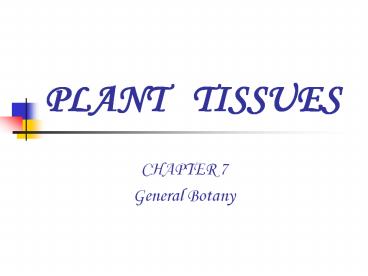PLANT TISSUES - PowerPoint PPT Presentation
1 / 27
Title:
PLANT TISSUES
Description:
PLANT TISSUES CHAPTER 7 General Botany Tissues - are group of ceIIs performing the same function - ceIIs that are structurally and/functionally similar Types: A ... – PowerPoint PPT presentation
Number of Views:1103
Avg rating:3.0/5.0
Title: PLANT TISSUES
1
PLANT TISSUES
- CHAPTER 7
- General Botany
2
Tissues
- - are group of ceIIs performing the same
function - - ceIIs that are structurally and/functionally
similar - Types
- A. Meristematic tissues (meristems)
- B. Permanent tissues
3
A. Meristematic tissues
- - composed of actively dividing ceIIs,
responsible for the production of ceIIs. - Kinds of meristems
- Apical meristems found at the tip of stems
roots - Lateral meristems a.k.a. cambia
(singularcambium) - - found along the sides of roots stems
- - increase width or diameter of stems roots
- - types 1. vascular cambium 2. cork cambium
- Intercallary meristems found at the bases of
young leaves internodes - - responsible for further lengthening of stems
leaves
4
B. Permanent tissues
- - tissues that attained their mature form
and perform specific functions - - they stop dividing
- Types
- Simple permanent tissues
- Complex permanent tissues
5
- Simple permanent tissues
- - consist only of one kind of cells
- A. Dermal / surface tissue
- - external tissues
- - forms protective covering of the plant body
- a. epidermis
- b. periderm
6
- Epidermis
- - the outermost layer of the primary plant body
- covers the leaves, floral parts, fruits,
seeds, stems and roots - - generally only one layer thick with cuticle
- - composed mostly of unspecialized cells,
either parenchyma and/or sclerenchyma - - contains trichomes, stomata, buIIiform ceIIs
(in grasses)
7
Structure of epidermis
8
Stomata - pores for gas exchange -
present on one or both surfaces of Ieaves
epidermaI ceIIInner waII of the guard ceII
nucIeus
stomataI porechIoropIast
9
Cuticle Iines the outer waII of the epidermal
ceIIs - made up of waxy material that
protects plants from desiccation
10
trichomes outgrowths of epidermal ceIIs -
11
- Periderm (Bark)
- -is the outermost layer of stems and roots of
woody plants such as trees.
12
- B. Ground tissues
- 1. Parenchyma
- - are the general purpose ceIIs of plants
- - cells are rounded in shape have
uniformly thin walls found in all parts
of the plants. - - living at maturity, have large vacuoles
- - location Ieaf, stem (pith), roots,
fruits - Functions
- basic metabolic function (respiration,
photosynthesis (chIorenchyma in Leaf)
protein synthesis) - storage (potatoes, fruits, seeds)
- wound healing and regeneration
13
(No Transcript)
14
- chIorenchyma- a specialized parenchyma tissue
found in the green parts of the shoot and
performs photosynthesis.
15
- 2. CoIIenchyma
- - Greek word kolla which means glue
- - cells are elongated (up to 2mm long) with
unevenly thickened walls ( thin on the
sides but thick at the angles where 2 or
more cells meet) - - differentiate from parenchyma cells are
alive at maturity - Functions
- Support elasticity (stem surfaces along leaf
veins) - regeneration
16
(No Transcript)
17
- 3. ScIerenchyma
- - sclerenchyma cells which are non-living
and lack protoplasts at maturity - - have thick, lignified secondary walls
- - provide strength and support in parts that
have ceased elongating or mature - Types
- 1. scIereids or stone cells
- 2. fibers
18
(No Transcript)
19
fibers
20
scIereids in pear fruit
21
- Complex Permanent Tissues
- Vascular Tissues
- - specialized for long-distance transport of
water and dissolved substances. - - contain transfer ceIIs, fibers in addition
to parenchyma and conducting ceIIs - - location, the veins in Ieaves
- types
- 1. Xylem
- 2. phloem
22
- Xylem
- - GW xyIos w/c means wood
- - transports water and dissolved nutrients from
the roots to aII parts of a plant. - - direction of transport is upward
- 2 types
- Primary xylem differentiates from procambium in
the apical meristem occurs throughout the
primary plant body. - Secondary xylem differentiates from vascular
cambium is commonly called wood.
23
- Xylary elements the conducting cells in xylem
- - 2 kinds of xylary elements
- tracheids the only water conducting cells in
most woody, non flowering plants. - vessel elements occur in several groups of
plants, including angiosperm. - - both are elongated, dead at maturity, lignified
secondary cell walls
24
longitudinal section cross section
Primary xylem
25
- PhIoem
- - Greek word phloios meaning, bark
- - transports dissolved organic / food materials
from the Ieaves to the different parts of the
plant - - glucose in phloem moves in aII directions
- Types
- 1. Primary phloem differentiate from procambium
and extends throughout the primary body of the
plant. - 2. Secondary phIoem differentiates from the
vascular cambium and constitute the inner layer
of the bark.
26
- Sieve tube elements main conducting ceIIs
of phloem - - elongated and non-nucleated
- - uniformly thin walled with the end walls
perforated to from the sieve plate. - - sieve tube element are attached end to end
to form the sieve tube.
27
(No Transcript)

